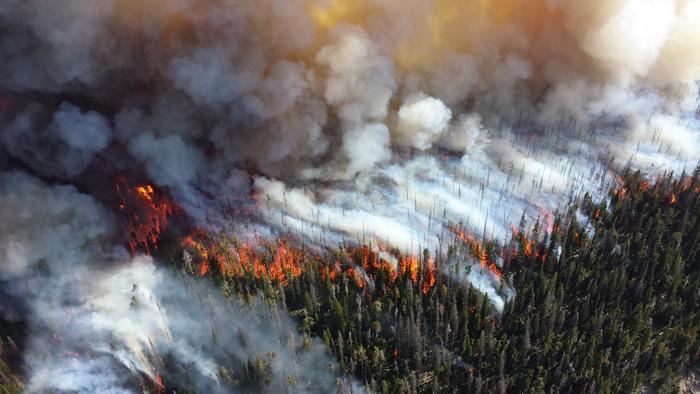In the evolving battle against devastating wildfires, new research from Canada and the United States offers promising advances in managing fire-prone forest landscapes. A recent study published in PLOS One introduces a novel optimization approach to designing fuelbreak strategies in Alberta’s volatile forest ecosystems. This methodology uniquely incorporates the inherent uncertainty of wildfire behavior, aiming to reduce the risks and impacts of large-scale fires by effectively compartmentalizing vulnerable landscapes.
Wildfires have long posed critical threats to forest health, human safety, and economic stability worldwide. Traditional approaches to wildfire management often consist of constructing fuelbreaks—controlled zones where vegetation is reduced or removed to slow fire spread. However, these methods typically assume predictable fire behavior, overlooking the complexities and stochastic nature of fire dynamics, especially in variable and changing climatic conditions. The newest research addresses these limitations by embedding probabilistic wildfire behavior within optimization models, yielding more adaptive and robust fuelbreak configurations.
At the core of this research lies the concept of compartmentalization, which involves subdividing large forested areas into smaller, more manageable segments. By doing so, wildfire containment efforts can focus on limiting fire to individual compartments rather than allowing it to traverse wide landscapes unchecked. The optimization framework developed integrates spatial, ecological, and fire-risk variables, enabling planners to strategically position fuelbreaks where their influence on fire containment is maximized under uncertain future fire scenarios.
Utilizing extensive datasets from Alberta’s forested regions, the research team applied their models to simulate multiple wildfire event scenarios. They incorporated variability factors such as wind direction, fuel moisture content, topography, and ignition points to realistically represent wildfire uncertainty. The simulations revealed that fuelbreak arrangements designed with this comprehensive uncertainty-aware optimization significantly outperform conventional fuelbreak layouts in preventing fire spread and protecting critical assets.
This methodological innovation also acknowledges the limitations imposed by resource availability and budget constraints typical in wildfire management programs. By formulating the problem as a multi-objective optimization, the approach balances the ecological costs of fuel reduction with the effectiveness of containment, ensuring that fuelbreak deployment is both feasible and efficient. This marks a substantial improvement over previous strategies that largely prioritized maximum fuel reduction without integrated risk assessment.
The implications for forest managers, policymakers, and emergency responders are profound. Incorporating stochastic wildfire dynamics into fuelbreak planning enhances decision-making processes by providing actionable insights that account for real-world variability. This adaptive planning can mitigate wildfire severity and frequency, contributing to increased forest resilience as climate change exacerbates fire regimes across North America and beyond.
Given the significant role Alberta plays in Canada’s forestry sector and its increasing wildfire vulnerability, the timing of this research is critical. Alberta’s heterogeneous landscapes, comprising mixed boreal forests and grasslands, create complex fire behaviors that demand sophisticated management tools. The optimized fuelbreak strategies presented in this work provide a blueprint for other regions with analogous fire-prone ecosystems seeking improved wildfire mitigation tactics.
Beyond operational utility, the study also contributes to the theoretical understanding of wildfire landscape ecology. By quantifying the interplay between spatial structure and fire behavior under uncertainty, it advances ecosystem management science. This foundation can lead to further innovations integrating remote sensing, machine learning, and real-time fire data to dynamically update fuelbreak networks in response to evolving fire risks.
Despite the technical advancements, the researchers underscored the necessity of maintaining ecological integrity. While fuelbreaks serve as critical fire barriers, they must be designed to preserve biodiversity and minimize habitat fragmentation. The optimization framework enables inclusion of conservation constraints, demonstrating that safety and sustainability in wildfire management are not mutually exclusive goals but complementary objectives.
Collaboration across borders was another hallmark of this study, with funding and expertise spanning Canadian and US governmental agencies, signaling the importance of international cooperation in addressing transboundary fire challenges. The alignment of wildfire risk management protocols between neighboring countries is essential for fostering resilient landscapes and safeguarding human communities at risk.
Looking forward, integrating this novel approach with emerging technologies like drones, AI-driven predictive analytics, and community-based monitoring could revolutionize fire management paradigms. Real-time adaptability coupled with robust optimization models has the potential to transform reactive firefighting into proactive landscape stewardship, enabling swift, informed responses before fire events escalate into catastrophic disasters.
In an era marked by increasing wildfire intensity, complexity, and uncertainty, this research highlights the power of sophisticated quantitative tools to enhance traditional fire mitigation strategies. By embracing fire behavior’s stochastic nature and strategically compartmentalizing landscapes through optimized fuelbreaks, forest managers gain a potent mechanism to protect ecosystems, economies, and lives.
Subject of Research: Fuelbreak optimization and wildfire risk management in fire-prone forest landscapes.
Article Title: Evaluating fuelbreak strategies for compartmentalizing a fire-prone forest landscape in Alberta, Canada
News Publication Date: 21-May-2025
Web References: http://dx.doi.org/10.1371/journal.pone.0321722
Image Credits: Mike Lewelling, National Park Service. This image contains material based on a work of a National Park Service employee, created as part of that person’s official duties. As a work of the U.S. federal government, such work is in the public domain in the United States. See the NPS website and NPS copyright policy for more information (CC0).
Keywords: Wildfire management, fuelbreak optimization, fire-prone landscapes, stochastic modeling, Alberta forests, fire compartmentalization, landscape ecology, probabilistic fire behavior, wildfire risk reduction, forest resilience




